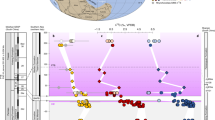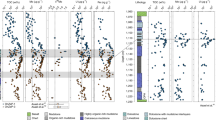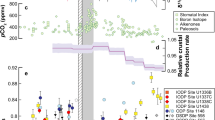Abstract
The origin and evolution of Earth’s biosphere were shaped by the physical and chemical histories of the oceans. Marine chemical sediments and altered oceanic crust preserve a geochemical record of these histories. Marine chemical sediments, for example, exhibit an increase in their 18O/16O ratio through time. The implications of this signal are ambiguous but are typically cast in terms of two endmember (but not mutually exclusive) scenarios. The oceans may have been much warmer in the deep past if they had an oxygen isotope composition similar to that of today. Alternatively, the nature of fluid–rock interactions (including the weathering processes associated with continental emergence) may have been different in the past, leading to an evolving oceanic oxygen isotope composition. Here we examine approximately 3.24-billion-year-old hydrothermally altered oceanic crust from the Panorama district in the Pilbara Craton of Western Australia as an alternative oxygen isotope archive to marine chemical sediments. We find that, at that time, seawater at Panorama had an oxygen isotope composition enriched in 18O relative to the modern ocean with a δ18O of 3.3 ± 0.1‰ VSMOW. We suggest that seawater δ18O may have decreased through time, in contrast to the large increases seen in marine chemical sediments. To explain this possibility, we construct an oxygen isotope exchange model of the geologic water cycle, which suggests that the initiation of continental weathering in the late Archaean, between 3 and 2.5 billion years ago, would have drawn down an 18O-enriched early Archaean ocean to δ18O values similar to those of modern seawater. We conclude that Earth’s water cycle may have gone through two separate phases of steady-state behaviour, before and after the emergence of the continents.
This is a preview of subscription content, access via your institution
Access options
Access Nature and 54 other Nature Portfolio journals
Get Nature+, our best-value online-access subscription
$29.99 / 30 days
cancel any time
Subscribe to this journal
Receive 12 print issues and online access
$259.00 per year
only $21.58 per issue
Buy this article
- Purchase on Springer Link
- Instant access to full article PDF
Prices may be subject to local taxes which are calculated during checkout



Similar content being viewed by others
Data availability
Oxygen isotope data and associated spatial data were previously published in refs. 18,21,23,25,26,40. Temperature data are mostly from the same references as the oxygen isotope data, with the exception of those for Panorama, which were from ref. 39.
We have provided all data used in the inversions in csv files in the Supplementary Information.
Code availability
All model code and data used for inversions are available in the Supplementary Information and on the corresponding author’s github repository (https://github.com/benwjohnson). In addition, the corresponding author is happy to send code upon email request.
References
Muehlenbachs, K. The oxygen isotopic composition of the oceans, sediments and the seafloor. Chem. Geol. 145, 263–273 (1998).
Prokoph, A., Shields, G. & Veizer, J. Compilation and time-series analysis of a marine carbonate δ 18O, δ 13C, 87Sr/86Sr and δ 34S database through Earth history. Earth Sci. Rev. 87, 113–133 (2008).
Muehlenbachs, K. & Clayton, R. Oxygen isotope composition of the oceanic crust and its bearing on seawater. J. Geophys. Res. 81, 4365–4369 (1976).
Chase, C. & Perry, E. C. The oceans: growth and oxygen isotope evolution. Science 177, 992–994 (1973).
Knauth, L. P. & Lowe, D. R. High Archean climatic temperature inferred from oxygen isotope geochemistry of cherts in the 3.5 Ga Swaziland Supergroup, South Africa. Geol. Soc. Am. Bull. 115, 566–580 (2003).
Jaffrés, J. B., Shields, G. A. & Wallmann, K. The oxygen isotope evolution of seawater: a critical review of a long-standing controversy and an improved geological water cycle model for the past 3.4 billion years. Earth Sci. Rev. 83, 83–122 (2007).
Galili, N. et al. The geologic history of seawater oxygen isotopes from marine iron oxides. Science 365, 469–473 (2019).
Garcia, A. K., Schopf, J. W., Yokobori, S.-i, Akanuma, S. & Yamagishi, A. Reconstructed ancestral enzymes suggest long-term cooling of Earth’s photic zone since the Archean. Proc. Natl Acad. Sci. USA 114, 4619–4624 (2017).
Kasting, J. F. et al. Paleoclimates, ocean depth, and the oxygen isotopic composition of seawater. Earth Planet. Sci. Lett. 252, 82–93 (2006).
Veizer, J. & Prokoph, A. Temperatures and oxygen isotopic composition of Phanerozoic oceans. Earth Sci. Rev. 146, 92–104 (2015).
Muehlenbachs, K. & Clayton, R. N. Oxygen isotope studies of fresh and weathered submarine basalts. Can. J. Earth Sci. 9, 172–184 (1972).
Muehlenbachs, K., Furnes, H., Fonneland, H. C. & Hellevang, B. Ophiolites as faithful records of the oxygen isotope ratio of ancient seawater: the Solund-Stavfjord Ophiolite Complex as a Late Ordovician example. Ophiolites Earth Hist. 218, 401–414 (2003).
Gregory, R. T. & Taylor, H. P. Jr An oxygen isotope profile in a section of Cretaceous oceanic crust, Samail Ophiolite, Oman: evidence for δ 18O buffering of the oceans by deep (>5 km) seawater-hydrothermal circulation at mid-ocean ridges. J. Geophys. Res. Solid Earth 86, 2737–2755 (1981).
Gregory, R. T. in Ophiolites in Earth History Vol. 218 (eds Dilek, Y. & Robinson, P. T.) 353–368 (Geological Society, 2003).
Turchyn, A. V. et al. Reconstructing the oxygen isotope composition of late Cambrian and Cretaceous hydrothermal vent fluid. Geochim. Cosmochim. Acta 123, 440–458 (2013).
Hodel, F. et al. Fossil black smoker yields oxygen isotopic composition of neoproterozoic seawater. Nat. Commun. 9, 1453 (2018).
DePaolo, D. J. Isotopic effects in fracture-dominated reactive fluid–rock systems. Geochim. Cosmochim. Acta 70, 1077–1096 (2006).
Norton, D. & Taylor, H. Jr Quantitative simulation of the hydrothermal systems of crystallizing magmas on the basis of transport theory and oxygen isotope data: an analysis of the Skaergaard intrusion. J. Petrol. 20, 421–486 (1979).
Wunsch, C. The Ocean Circulation Inverse Problem (Cambridge Univ. Press, 1996).
Wing, B. A. & Ferry, J. M. Three-dimensional geometry of metamorphic fluid flow during Barrovian regional metamorphism from an inversion of combined petrologic and stable isotopic data. Geology 30, 639–642 (2002).
Wing, B. A. & Ferry, J. M. Magnitude and geometry of reactive fluid flow from direct inversion of spatial patterns of geochemical alteration. Am. J. Sci. 307, 793–832 (2007).
Taylor, H. P. Water/rock interactions and the origin of H2O in granitic batholiths: thirtieth William Smith lecture. J. Geolog. Soc. 133, 509–558 (1977).
Cathles, L. M. in The Kuroko and Related Volcanogenic Massive Sulfide Deposits Vol. 5 (eds Ohmoto, H. & Skinner, B. J.) 439–487 (Economic Geology Publishing, 1983).
Taylor, H. P. Jr & Forester, R. W. An oxygen and hydrogen isotope study of the Skaergaard intrusion and its country rocks: a description of a 55-M.Y. old fossil hydrothermal system. J. Petrol. 20, 355–419 (1979).
Gillis, K. M., Muehlenbachs, K., Stewart, M., Gleeson, T. & Karson, J. Fluid flow patterns in fast spreading East Pacific Rise crust exposed at Hess Deep. J. Geophys. Res. Solid Earth 106, 26311–26329 (2001).
Green, G. R., Ohmoto, H., Date, J. & Takahashi, T. in The Kuroko and Related Volcanogenic Massive Sulfide Deposits Vol. 5 (eds Ohmoto, H. & Skinner, B. J.) 395–411 (Economic Geology Publishing, 1983).
Schiffman, P. & Smith, B. M. Petrology and oxygen isotope geochemistry of a fossil seawater hydrothermal system within the Solea graben, northern Troodos ophiolite, Cyprus. J. Geophys. Res. Solid Earth 93, 4612–4624 (1988).
Mukasa, S. B. & Ludden, J. N. Uranium-lead isotopic ages of plagiogranites from the Troodos ophiolite, Cyprus, and their tectonic significance. Geology 15, 825–828 (1987).
Lear, C., Elderfield, H. & Wilson, P. Cenozoic deep-sea temperatures and global ice volumes from Mg/Ca in benthic foraminiferal calcite. Science 287, 269–272 (2000).
Vearncombe, S. et al. 3.26 Ga black smoker-type mineralization in the Strelley Belt, Pilbara Craton, Western Australia. J. Geol. Soc. 152, 587–590 (1995).
Brauhart, C. W., Groves, D. I. & Morant, P. Regional alteration systems associated with volcanogenic massive sulfide mineralization at Panorama, Pilbara, Western Australia. Econ. Geol. 93, 292–302 (1998).
Buick, R. et al. Geochronology and stratigraphic relationships of the Sulphur Springs Group and Strelley Granite: a temporally distinct igneous province in the Archaean Pilbara Craton, Australia. Precambrian Res. 114, 87–120 (2002).
Van Kranendonk, M. J. et al. Making it thick: a volcanic plateau origin of Palaeoarchean continental lithosphere of the Pilbara and Kaapvaal cratons. Geol. Soc. Spec. Publ. 389, 83–111 (2015).
Kato, Y. & Nakamura, K. Origin and global tectonic significance of Early Archean cherts from the Marble Bar greenstone belt, Pilbara Craton, Western Australia. Precambrian Res. 125, 191–243 (2003).
Nijman, W., Kloppenburg, A. & de Vries, S. T. Archaean basin margin geology and crustal evolution: an East Pilbara traverse. J. Geol. Soc. 174, 1090–1112 (2017).
Martindale, J., Hagemann, S., Huston, D. & Danyushevsky, L. Integrated stratigraphic–structural–hydrothermal alteration and mineralisation model for the Kangaroo Caves zinc–copper deposit, Western Australia. Aust. J. Earth Sci. 61, 159–185 (2014).
Huston, D. L., Brauhart, C. W., Drieberg, S. L., Davidson, G. J. & Groves, D. I. Metal leaching and inorganic sulfate reduction in volcanic-hosted massive sulfide mineral systems: evidence from the paleo-Archean Panorama district Western Australia. Geology 29, 687–690 (2001).
Brauhart, C. W., Huston, D. L., Groves, D. I., Mikucki, E. J. & Gardoll, S. J. Geochemical mass-transfer patterns as indicators of the architecture of a complete volcanic-hosted massive sulfide hydrothermal alteration system, Panorama District, Pilbara, Western Australia. Econ. Geol. 96, 1263–1278 (2001).
Drieberg, S. L. et al. The interplay of evolved seawater and magmatic-hydrothermal fluids in the 3.24 Ga Panorama volcanic-hosted massive sulfide hydrothermal system, North Pilbara Craton, Western Australia. Econ. Geol. 108, 79–110 (2013).
Brauhart, C., Huston, D. & Andrew, A. Oxygen isotope mapping in the Panorama VMS district, Pilbara Craton, Western Australia: applications to estimating temperatures of alteration and to exploration. Mineral. Depos. 35, 727–740 (2000).
Pope, E. C., Bird, D. K. & Rosing, M. T. Isotope composition and volume of Earth’s early oceans. Proc. Natl Acad. Sci. USA 109, 4371–4376 (2012).
Silverman, S. R. The isotope geology of oxygen. Geochim. Cosmochim. Acta 2, 26–42 (1951).
Gregory, R. T. in Stable Isotope Geochemistry: A tribute to Samuel Epstein Vol. 3 (eds Taylor, Jr., H. P., O’Neil, J. R. & Kaplan, I. R.) 65–76 (Geochemical Society, 1991).
Eiler, J. M. Oxygen isotope variations of basaltic lavas and upper mantle rocks. Rev. Mineral. Geochem. 43, 319–364 (2001).
Lebrun, T. et al. Thermal evolution of an early magma ocean in interaction with the atmosphere. J. Geophys. Res. Planets 118, 1155–1176 (2013).
Holland, H. D. The Chemical Evolution of the Atmosphere and Oceans (Princeton Univ. Press, 1984).
Korenaga, J. Initiation and evolution of plate tectonics on Earth: theories and observations. Annu. Rev. Earth Planet. Sci. 41, 117–151 (2013).
Buick, R. et al. Record of emergent continental crust ~3.5 billion years ago in the Pilbara craton of Australia. Nature 375, 574–577 (1995).
Grandstaff, D., Edelman, M., Foster, R., Zbinden, E. & Kimberley, M. Chemistry and mineralogy of Precambrian paleosols at the base of the Dominion and Pongola Groups (Transvaal, South Africa). Precambrian Res. 32, 97–131 (1986).
Bindeman, I., Bekker, A. & Zakharov, D. Oxygen isotope perspective on crustal evolution on early Earth: a record of Precambrian shales with emphasis on paleoproterozoic glaciations and great oxygenation event. Earth Planet. Sci. Lett. 437, 101–113 (2016).
Korenaga, J., Planavsky, N. J. & Evans, D. A. Global water cycle and the coevolution of the Earth as interior and surface environment. Phil. Trans. R. Soc. A 375, 20150393 (2017).
Taylor, S. R. & McLennan, S. M. The geochemical evolution of the continental crust. Rev. Geophys. 33, 241–265 (1995).
Simon, L. & Lècuyer, C. Continental recycling: the oxygen isotope point of view. Geochem. Geophys. Geosyst. 6, Q08004 (2005).
Molnar, P. Gravitational potential energy per unit area as a constraint on Archean sea level. Geochem. Geophys. Geosyst. 19, 4063–4095 (2018).
Cowan, N. B. & Abbot, D. S. Water cycling between ocean and mantle: super-earths need not be waterworlds. Astrophys. J. 781, 27 (2014).
Laverne, C., Agrinier, P., Hermitte, D. & Bohn, M. Chemical fluxes during hydrothermal alteration of a 1200-m long section of dikes in the oceanic crust, DSDP/ODP Hole 504B. Chem. Geol. 181, 73–98 (2001).
Cole, D. R., Mottl, M. J. & Ohmoto, H. Isotopic exchange in mineral–fluid systems. II. Oxygen and hydrogen isotopic investigation of the experimental basalt–seawater system. Geochim. Cosmochim. Acta 51, 1523–1538 (1987).
Stakes, D. S. & Taylor, H. P. in Ophiolites in Earth History Vol. 218 (eds Dilek, Y. & Robinson, P. T.) 315–351 (Geological Society, 2003).
Wanless, V. et al. Volatile abundances and oxygen isotopes in basaltic to dacitic lavas on mid-ocean ridges: the role of assimilation at spreading centers. Chem. Geol. 287, 54–65 (2011).
Grimes, C. B., Ushikubo, T., Kozdon, R. & Valley, J. W. Perspectives on the origin of plagiogranite in ophiolites from oxygen isotopes in zircon. Lithos 179, 48–66 (2013).
Acknowledgements
We acknowledge NSF grant support for B.W.J. (EAR-PF 1725784) and B.A.W. (EF 1724393), as well as the American Philosophical Society’s Lewis and Clark Grant for field work in Astrobiology to B.W.J. We thank C. Brauhart for discussions on the geology of Panorama and guidance in the field, and E. Pope for constructive criticism that materially improved the paper in scope and detail.
Author information
Authors and Affiliations
Contributions
B.W.J. and B.A.W. conceived the project. B.A.W. developed the inverse method. B.W.J. performed the data assimilation, inverse modelling and ocean isotope exchange modelling. B.W.J. and B.A.W. interpreted model results and wrote the manuscript.
Corresponding author
Ethics declarations
Competing interests
The authors declare no competing interests.
Additional information
Peer review information Primary Handling Editor: Rebecca Neely.
Publisher’s note Springer Nature remains neutral with regard to jurisdictional claims in published maps and institutional affiliations.
Extended data
Extended Data Fig. 1 Estimated fluid rock ratios for ‘leave-one-out’ inversions.
Water/rock ratio results of ‘leave-one-out’ inversions, removing one sample each time for all synthetic datasets (21; 18; 23).
Extended Data Fig. 2 Estimated incoming fluid oxygen isotope composition from synthetic datasets.
Results of ‘leave-one-out’ inversions, removing one sample each time (21; 18; 23). Each set of inversions has the same number of runs as there are samples for each set. Arrows indicate imposed incoming fluid δ18O, and inset shows the models on the same isotopic scale as the crustal sections in Fig. 2.
Extended Data Fig. 3 δ18O and temperature contours for all datasets.
The third column shows the true aspect ratio of all datasets, highlighting that the geometry of the study area does not affect inverse estimates.
Extended Data Fig. 4 Schematic of the Earth system water cycle.
Fluxes in bold are used in the kinetic model for seawater δ18O, while those in italics are not considered to be important isotopically for the long-term evolution of seawater δ18O.
Extended Data Fig. 5 Modeled oxygen isotope exchange rates over time.
Oxygen isotope exchange rates used to make different δ18O curves in Figure 3. We assume 2 - 4% modern exchange rates initially for the first row, which then increase to modern rates by 2.5 Ga The second through fourth rows impose continental emergence at 4.4, 3, and 0.9 Ga, increasing to modern values over ≈ 500 million years.
Supplementary information
Supplementary Information
Supplementary Figs. 1–5 and Tables 1 and 2.
Supplementary Data 1
The oxygen isotope and temperature data for the Panorama VMS district, Australia.
Supplementary Data 2
The sampled dataset from Wing and Ferry21 used to tune the smoothing parameter for the inverse model.
Supplementary Data 3
The kinetic forward model data from Cathles23 used to validate the smoothing parameter.
Supplementary Data 4
The oxygen isotope and temperature data from the East Pacific Rise (Gillis et al.25).
Supplementary Data 5
The oxygen isotope and temperature data from Fukazawa district for inversion (Green et al.26).
Supplementary Data 6
The oxygen isotope and temperature data used in the inversion from the Solea Graben (Schiffman and Smith27).
Supplementary Data 7
The oxygen isotope data from Lear et al.29 used as a record of Cenozoic seawater.
Supplementary Data 8
The sample set from the oxygen isotope model results from Norton and Taylor18 of plagioclase in the Skaergaard intrusion.
Supplementary Software 1
These files include a read_me (describes the contents of the zipped file and how to run the code), matrix_average.py (helps make the grid structure for the inversion), nan_helper.py (helps remove nans from datasets), o_isotope_invert.py (takes input data and inverts to estimate the total fluid input) and model_code_driver.py (wrapper file that calls all needed codes and produces figures).
Rights and permissions
About this article
Cite this article
Johnson, B.W., Wing, B.A. Limited Archaean continental emergence reflected in an early Archaean 18O-enriched ocean. Nat. Geosci. 13, 243–248 (2020). https://doi.org/10.1038/s41561-020-0538-9
Received:
Accepted:
Published:
Issue Date:
DOI: https://doi.org/10.1038/s41561-020-0538-9
This article is cited by
-
Modern analogs for ammonia flux from terrestrial hydrothermal features to the Archean atmosphere
Scientific Reports (2024)
-
Crustal carbonate build-up as a driver for Earth’s oxygenation
Nature Geoscience (2024)
-
Emergence of felsic crust and subaerial weathering recorded in Palaeoarchaean barite
Nature Geoscience (2022)
-
Large influence of dust on the Precambrian climate
Nature Communications (2020)



